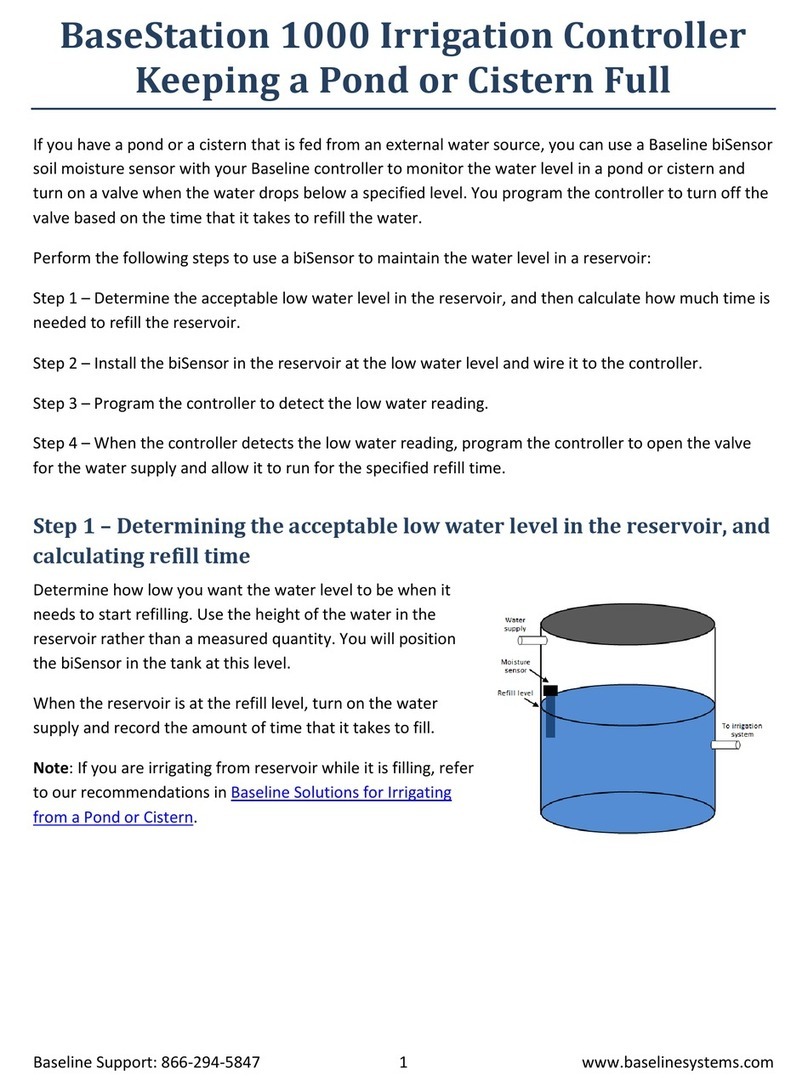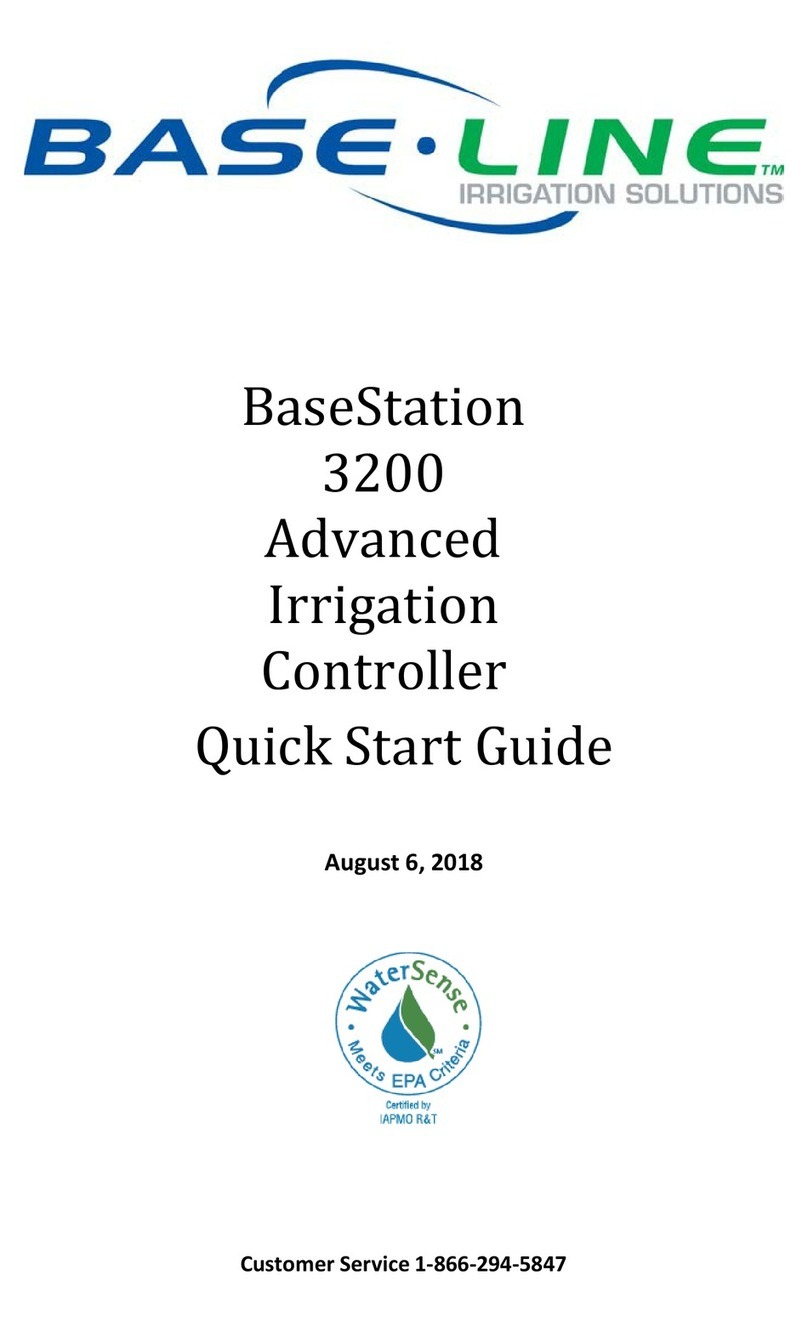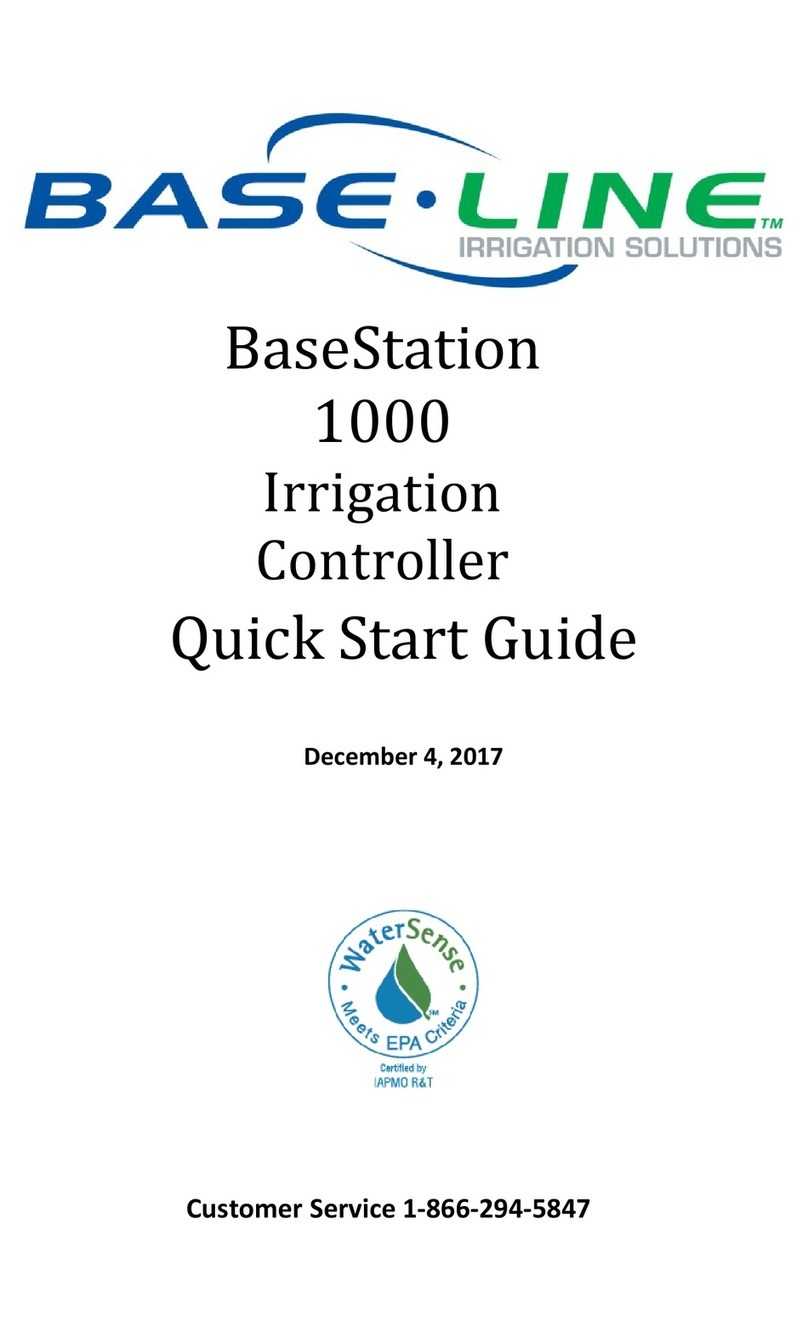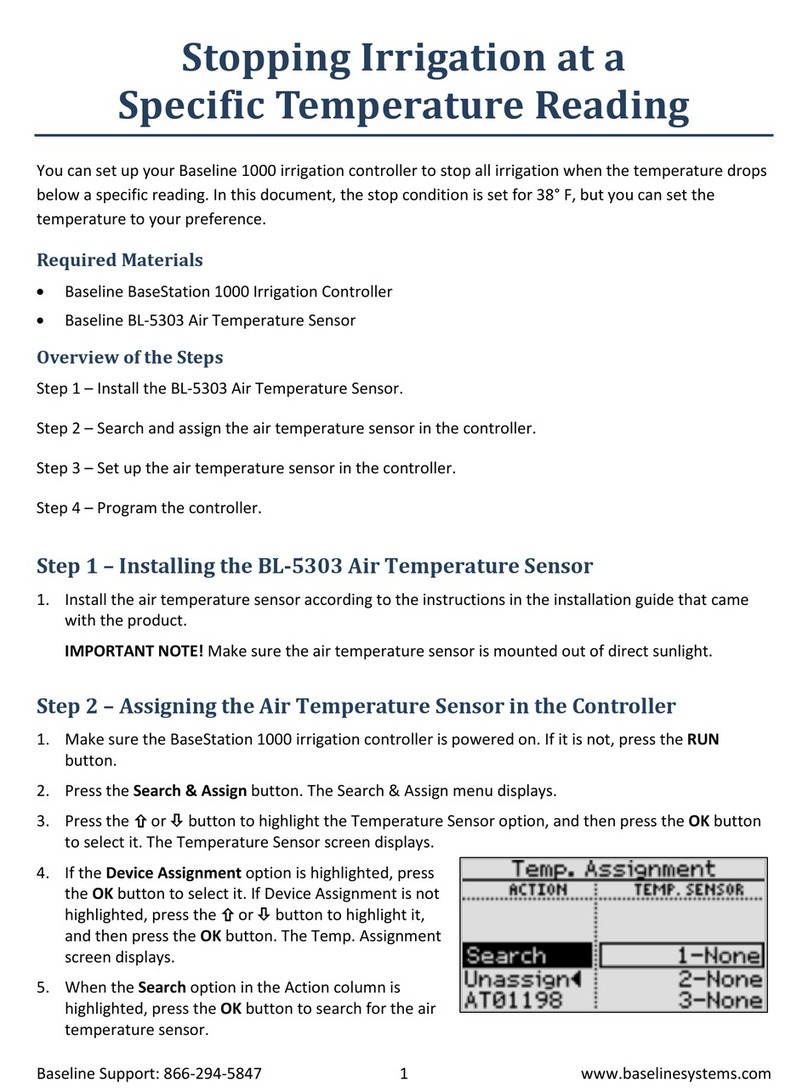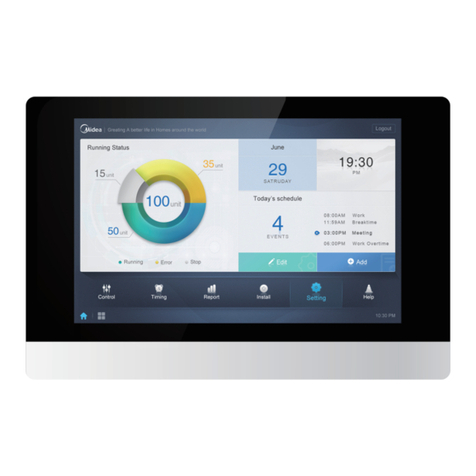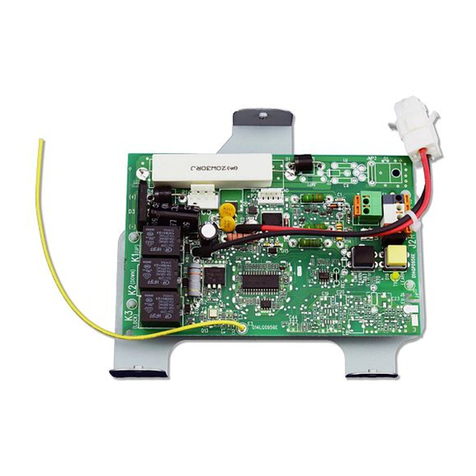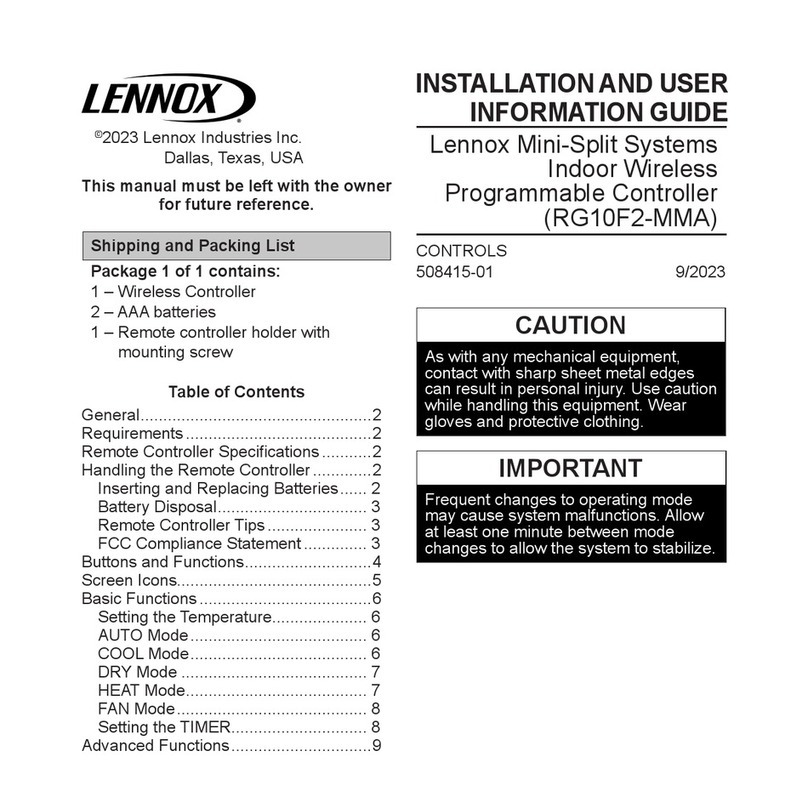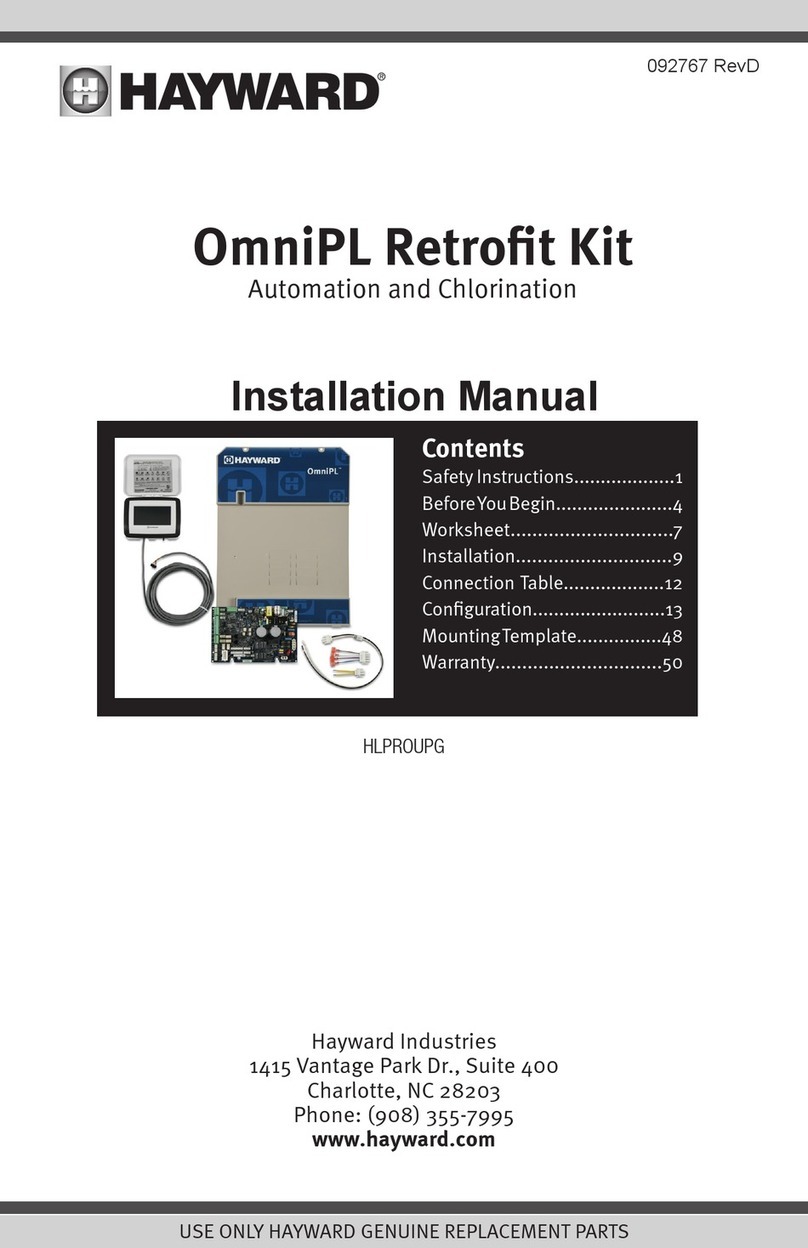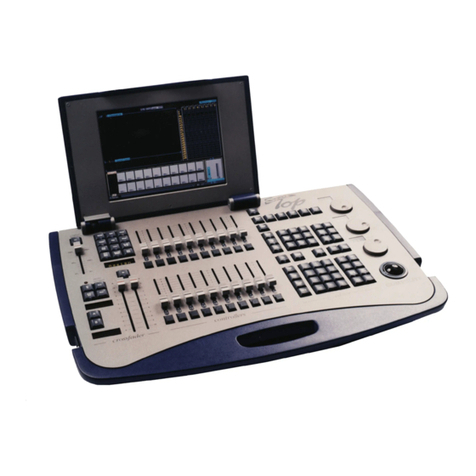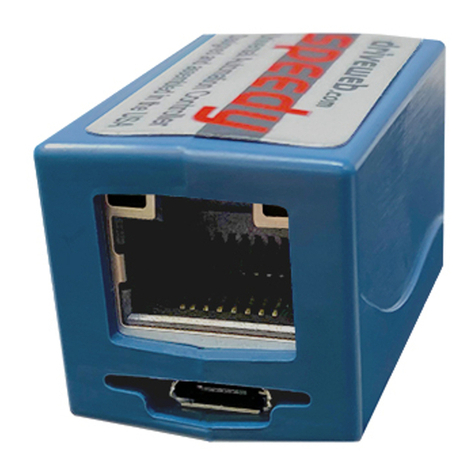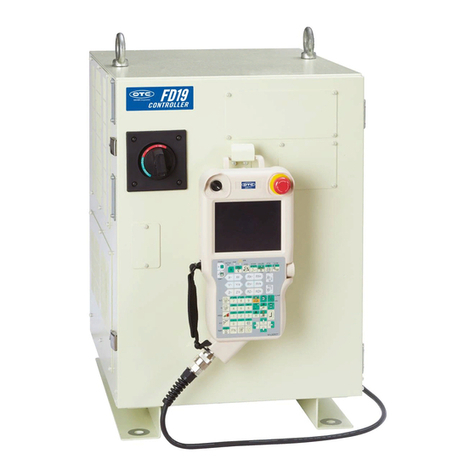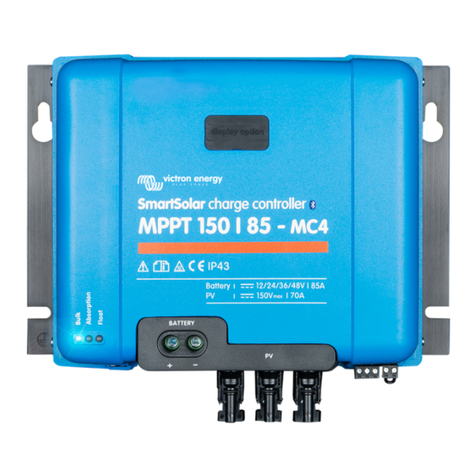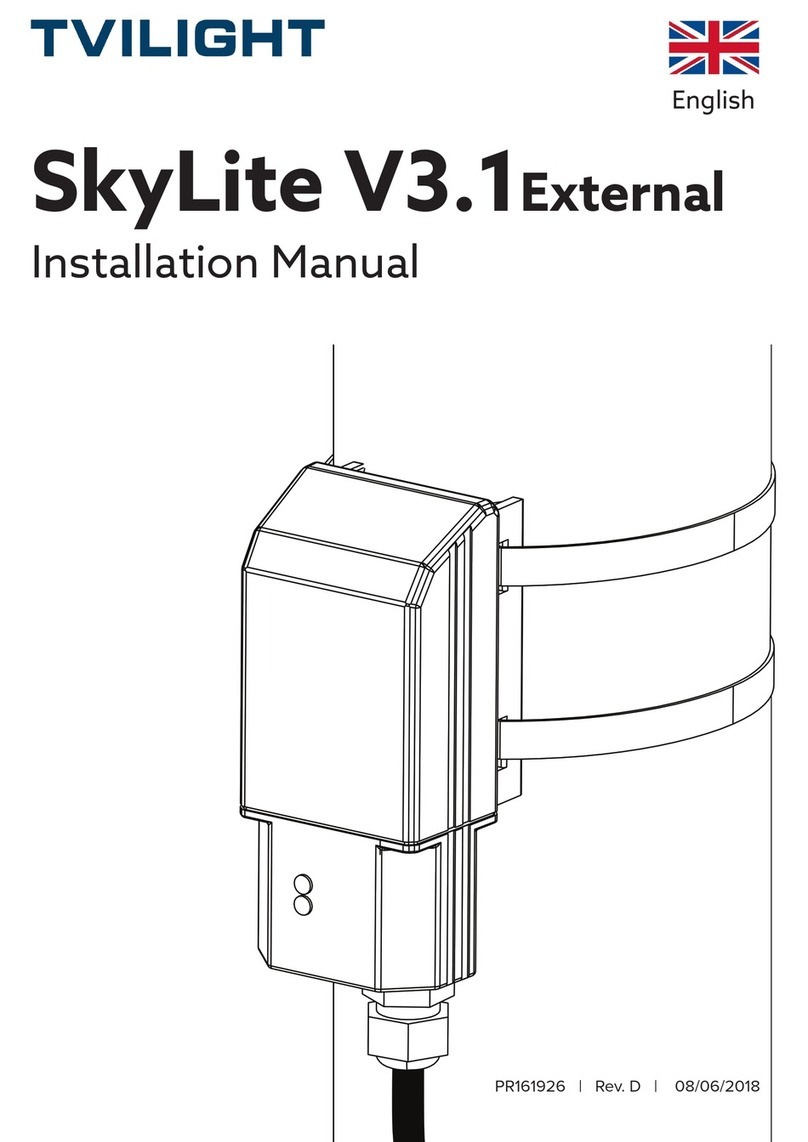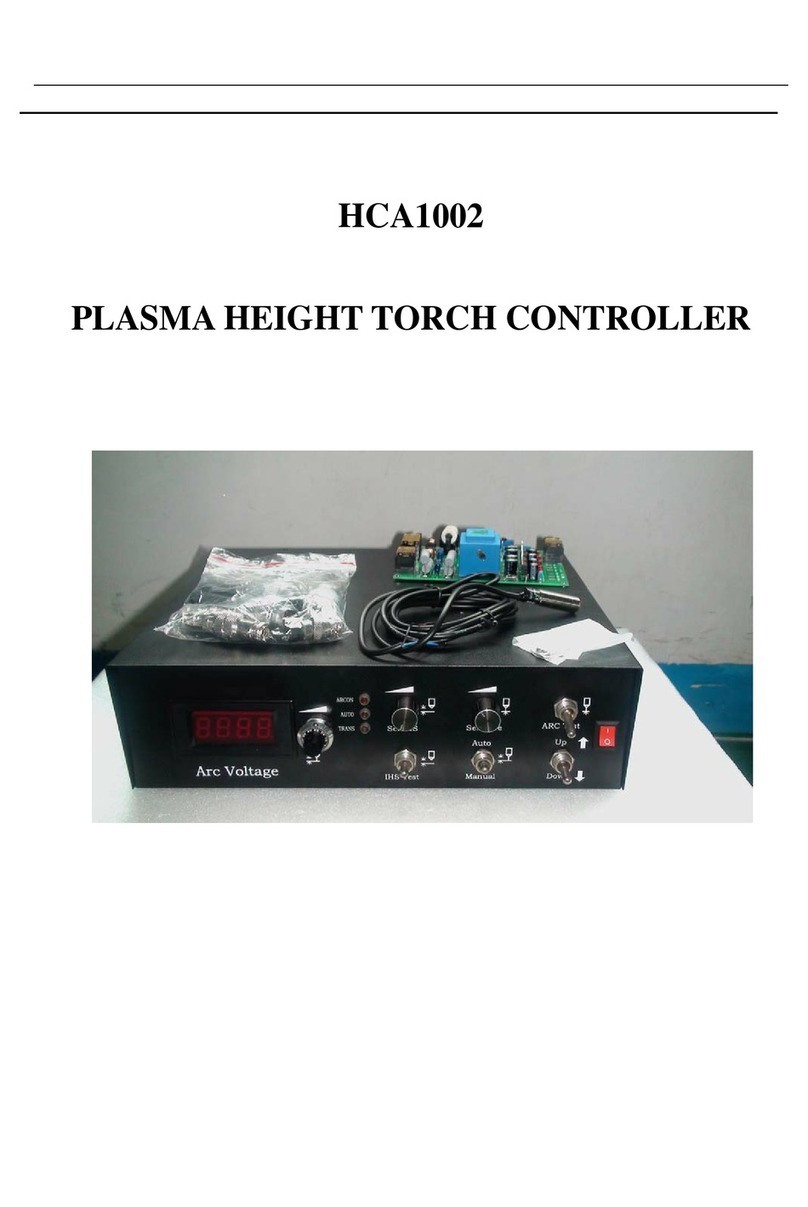Base Line BaseStation 3200 User manual

BaseStation 3200
Advanced Irrigation
Controller
User Manual
Software Version 11.7.5.15
April 17, 2012
Contents at a Glance
Section 1 Introduction
Section 2 System Components
Section 3 Wiring Guidelines
Section 4 BaseStation 3200 Interface
Section 5 Configuring Devices
Section 6 Initial Programming
Section 7 Flow Management & Monitoring
Section 8 Manual Operations
Section 9 System Management
Section 10 Reports, Messages, Alerts, & Logs
Section 11 Troubleshooting
Section 12 Appendix
Customer Service 1-866-294-5847

Baseline Inc.
www.baselinesystems.com
Phone 208-323-1634
FAX 208-323-1834
Toll Free 866-294-5847
©2012 Baseline Inc. All Rights Reserved.
Revision 2

Page i
Table of Contents
1 – INTRODUCTION................................................................................................................................1
How to Read this Manual................................................................................................................................ 1
How to Irrigate Efficiently ............................................................................................................................... 1
Soil Moisture Content ..................................................................................................................................... 2
How to Use Soil Moisture Sensors Successfully............................................................................................... 3
Choosing the Primary Zone for a Scheduling Group.........................................................................................4
Choosing the Sensor Location...........................................................................................................................5
Dealing with Slopes and Berms ....................................................................................................................5
Optimal biSensor Placement for Slopes and Berms .....................................................................................5
Burying the biSensor.........................................................................................................................................5
Turf Grass .....................................................................................................................................................6
Newly Seeded Turf Grass or New Sod ..........................................................................................................6
Trees and Shrubs ..........................................................................................................................................6
Installing biSensors with New Trees.............................................................................................................7
Shrubs and Other Ornamental Plants...........................................................................................................7
Gardens and Crop Plants ..............................................................................................................................7
Watering Strategies ........................................................................................................................................ 7
Root Depth and Plant Water Efficiency ........................................................................................................... 8
Understanding Soak Cycling............................................................................................................................ 9
Precipitation Rates vs. Infiltration Rates...........................................................................................................9
Precipitation Rates for Common Sprinkler Types.........................................................................................9
Estimated Infiltration Rates for Common Soil Types....................................................................................9
Distribution Uniformity................................................................................................................................. 10
2 – SYSTEM COMPONENTS ............................................................................................................... 11
Cabinet Options ............................................................................................................................................ 11
Remote Communications Options ................................................................................................................ 11
BaseManager ..................................................................................................................................................11
BL Commander ...............................................................................................................................................12
Two-Wire Devices ......................................................................................................................................... 12
Total Supported Devices and Limits ...............................................................................................................13
Maximum Concurrent Valves .....................................................................................................................14
Maximum Wire Distances for 3200R and 5200R Series biCoders ..............................................................14
Installing the BaseStation 3200 Enclosure..................................................................................................... 14
C-series Wall Mount Cabinets.........................................................................................................................14
Connecting Power and Ground ..................................................................................................................15
X/XS-series Wall Mount Cabinets ...................................................................................................................15
Connecting Power and Ground ..................................................................................................................16
Remote Connection Modules and Antennas..............................................................................................16
P-series Pedestal Cabinets ..............................................................................................................................16
Mounting the Pedestal to a Concrete Platform .........................................................................................16
Remote Connection Modules and Antennas..............................................................................................17
3 – WIRING GUIDELINES ................................................................................................................... 18
Conventional Irrigation Wiring Installation ................................................................................................... 18
Conventional Wiring Modules ........................................................................................................................18
Connecting Valve Wires and Moisture Sensors over Valve Wires..................................................................19
BL-5200 Series Powered biCoder Wiring Example with One biSensor.......................................................19
Expanding with Two-Wire...............................................................................................................................20
Connecting to BL-5200R Series Wall Mount biCoders....................................................................................21
Example Wiring Diagram ............................................................................................................................21

Page ii
Two-Wire Installation ................................................................................................................................... 21
Two-Wire Serial Numbers...............................................................................................................................22
Two-Wire Connections and Layout.................................................................................................................22
Wire Connections .......................................................................................................................................22
Wire Lengths...............................................................................................................................................22
Wire Layout ................................................................................................................................................23
Wire Burial..................................................................................................................................................23
Installing Two-Wire Devices.......................................................................................................................... 24
Wiring a Valve biCoder ...................................................................................................................................24
Wiring Surge Protection and Lightning Arrestors ...........................................................................................25
Installation Instructions..............................................................................................................................25
Wiring a Soil Moisture Sensor (biSensor™).....................................................................................................26
Wiring a Temperature Sensor (biSensor™).....................................................................................................26
Wiring a Pump Start Relay ..............................................................................................................................27
Wiring a Flow Device ......................................................................................................................................27
Wiring a Flow Device +NOMV.........................................................................................................................28
Wiring a Water Meter.....................................................................................................................................29
Pause Devices .................................................................................................................................................30
Wiring a Pause Button................................................................................................................................30
Wiring a Pause biCoder ..............................................................................................................................30
Wiring a Rain Switch and Other Normally Closed Sensing Devices ................................................................31
Connecting a Rain Switch to the BaseStation 3200....................................................................................31
Pause Behavior for the Different Connections...........................................................................................31
Watering Behavior for the Different Ports .................................................................................................31
Wireless Rain Sensors .....................................................................................................................................32
Removing a Two-Wire Device ....................................................................................................................... 32
4 –BASESTATION 3200 INTERFACE .............................................................................................. 33
Controller Front Panel Layout ....................................................................................................................... 33
On-Screen Help ............................................................................................................................................. 34
Auto Run Main Screen .................................................................................................................................. 34
Status Colors................................................................................................................................................. 35
On-Screen Reports........................................................................................................................................ 35
5 – CONFIGURING DEVICES .............................................................................................................. 36
Searching for Devices.................................................................................................................................... 36
Searching for biCoders (including Powered biCoders) ...................................................................................36
Searching for biSensors ..................................................................................................................................37
Searching for Flow biCoders (including those associated with a Master Valve) ............................................37
Searching for Pause biCoders and Temperature Sensors...............................................................................37
Assigning Valve biCoders to Zone Numbers .................................................................................................. 38
Zone Numbers are Pre-Assigned in R-Series...................................................................................................38
Assigning biCoders to Zones ...........................................................................................................................38
Clearing a Previous Zone Number Assignment...............................................................................................38
Understanding Zone Statuses.........................................................................................................................39
Adjusting the Valve Power Level for a biCoder.............................................................................................. 39
Configuring Other Devices ............................................................................................................................ 40
Assigning Soil Moisture Sensors (biSensors) to Primary Zones ......................................................................40
Configuring Pause Devices..............................................................................................................................40
Configuring Flow biCoders, Flow Meters, and Flow Sensors..........................................................................41
Configuring a Master Valve/Pump Start biCoder ...........................................................................................41
Associating a Master Valve/Pump Start biCoder with Programs ...................................................................41

Page iii
6 – INITIAL PROGRAMMING............................................................................................................. 42
Power Cycling or Restarting the Controller ................................................................................................... 42
Setting the Controller Date and Time............................................................................................................ 42
Checking the Software Version on Your Controller ....................................................................................... 42
Setting Up Time-Based Watering .................................................................................................................. 43
Setting Up a Timed Zone.................................................................................................................................43
To set up a timed zone ...............................................................................................................................43
Modifying the Default Settings for a Zone......................................................................................................43
To modify the default settings for a zone ..................................................................................................44
Assigning a Primary Zone................................................................................................................................44
Prerequisites...............................................................................................................................................44
To assign a primary zone ............................................................................................................................45
Linking Zones (Creating a Scheduling Group) .................................................................................................45
Adjusting the Water Time Tracking Ratio of Linked Zones.............................................................................45
Using Soak Cycles.......................................................................................................................................... 46
To enable the default soak-cycle settings.......................................................................................................46
To change soak-cycle settings for timed zones ..............................................................................................47
To disable soak cycles .....................................................................................................................................47
Setting Up Programs ..................................................................................................................................... 47
To set up the start times for a program..........................................................................................................48
To set up the water windows for a program ..................................................................................................48
To set up the day intervals for a program ......................................................................................................49
To set up historical ET-based watering for a program....................................................................................49
Prerequisites...............................................................................................................................................49
Instructions.................................................................................................................................................50
To adjust the water budget for programs ......................................................................................................50
Associating Zones with a Program ................................................................................................................ 51
Setting Up Soil Moisture Sensor Based Watering.......................................................................................... 51
Prerequisites for Watering with Soil Moisture Sensors..................................................................................52
To configure your biSensors and set up watering strategies..........................................................................52
Understanding Upper and Lower Limit Watering Strategies ......................................................................... 53
Lower Limit .....................................................................................................................................................53
Manual........................................................................................................................................................53
Auto ............................................................................................................................................................53
Upper Limit .....................................................................................................................................................54
Manual........................................................................................................................................................54
Auto ............................................................................................................................................................54
Complying with Water Restrictions............................................................................................................... 55
Setting Up Event Days................................................................................................................................... 56
To add a new event day..................................................................................................................................56
To edit existing event days .............................................................................................................................56
To remove an event day .................................................................................................................................56
7 – FLOW MANAGEMENT & MONITORING.................................................................................. 57
Configuring a Flow Device............................................................................................................................. 57
Flow Device Limits and Monthly Budget ........................................................................................................58
To configure the flow device limits ............................................................................................................59
Mainline Setup................................................................................................................................................59
To set up the mainline................................................................................................................................61
Managing Concurrent Zones...........................................................................................................................61
Example ......................................................................................................................................................62
To manage concurrent zones by controller and program..........................................................................62
Learning Flow..................................................................................................................................................62

Page iv
Learning the Flow by Program....................................................................................................................62
Learning the Flow by Zone .........................................................................................................................63
Multiple Flow Devices and Mainlines............................................................................................................ 64
To assign mainline numbers to your flow devices and programs...................................................................64
8 – MANUAL OPERATIONS................................................................................................................ 65
Manually Running a Program........................................................................................................................ 65
Forcing a Program to Start..............................................................................................................................65
Stopping an Active Program ...........................................................................................................................65
Setting the Next Start Date for a Program......................................................................................................66
Watering Manually ....................................................................................................................................... 66
Manually Running One Zone ..........................................................................................................................66
Manually Running All Zones ...........................................................................................................................67
Manually Running the Zones of a Program ....................................................................................................68
Setting Up a Rain Delay................................................................................................................................. 69
To set up a rain delay......................................................................................................................................69
To clear a rain delay........................................................................................................................................69
Setting the System to OFF............................................................................................................................. 69
9 – SYSTEM MANAGEMENT .............................................................................................................. 70
Setting Up a Passcode................................................................................................................................... 70
Changing the Serial Number of Your Controller ............................................................................................ 70
Using the USB Data Functions....................................................................................................................... 71
Backing Up Your System .................................................................................................................................71
Restoring Your System....................................................................................................................................71
Exporting Log Files ..........................................................................................................................................72
Importing Log Files..........................................................................................................................................72
Updating the Controller Software................................................................................................................. 73
To download the software from the Baseline web site..................................................................................73
To unzip the compressed update file .............................................................................................................73
To copy the Update folder to your USB drive.................................................................................................73
To update the software on the controller ......................................................................................................74
Using the Clear All Option ............................................................................................................................. 74
10 – REPORTS, MESSAGES, ALERTS, & LOGS .............................................................................. 75
Zone Status................................................................................................................................................... 75
Program Status ............................................................................................................................................. 76
To display the Program Status report.............................................................................................................76
Moisture Sensor Data ................................................................................................................................... 77
To display the Soil Moisture Sensor Data report............................................................................................77
Water Used................................................................................................................................................... 77
To display the Water Used reports.................................................................................................................77
Pause Conditions .......................................................................................................................................... 78
To display the Pause Conditions report..........................................................................................................79
Operator Messages....................................................................................................................................... 79
To display the Messages .................................................................................................................................79
Viewing Exported Log Files ........................................................................................................................... 80
Saving Exported Log Files to a Computer ...................................................................................................... 80
11 – TROUBLESHOOTING ................................................................................................................. 82
Testing Zones, Valves, and biCoders ............................................................................................................. 82
Testing Soil Moisture Sensors (biSensors) ..................................................................................................... 83
Testing All Devices ........................................................................................................................................ 84
Repairing Device Assignments and Addresses............................................................................................... 85

Page v
Troubleshooting the Two-Wire: High Current or Shorted.............................................................................. 85
Troubleshooting: Lost Devices | No Response .............................................................................................. 86
12 – APPENDIX ..................................................................................................................................... 87
Warranty ...................................................................................................................................................... 87
BL-3200-R Hydrozone Worksheet ................................................................................................................. 88
Existing Irrigation Controller Information.......................................................................................................88
Additional Information for Existing Programs ................................................................................................89
Programming Information for the BaseStation 3200 Controller ....................................................................89
Additional Information for New Programs .....................................................................................................90
Glossary of Terms ......................................................................................................................................... 91

Page vi

BaseStation 3200 Advanced Irrigation Controller Manual
Page 1
1 – INTRODUCTION
Congratulations on choosing the most capable and easiest to use commercial grade smart irrigation controller in
the world! You will find that the BaseStation 3200 is capable of dramatically reducing your water use while
improving the health and quality of your landscape. Fully central control compatible, the BaseStation 3200
controller will typically pay for itself in one to two seasons based on water waste reduction alone.
The BaseStation 3200 is specifically designed to help you irrigate more efficiently than any other commercial
irrigation controller. The 3200 supports multiple smart watering strategies, including Historical ET, and smart
watering with soil moisture sensors.
At Baseline, our mission is to change the way people water plants by providing the smartest, easiest and most
capable irrigation control products ever made. If you have feedback on how we can make our products better,
please do not hesitate to contact us.
IMPORTANT NOTE! Install all electrical components including the BaseStation controller in compliance with local
electrical and building codes.
How to Read this Manual
For first time users, sections 1 through 6 provide an overview of how to get your new BaseStation 3200 controller
up and running quickly, while sections 7 through 10 provide information on advanced functions and
troubleshooting.
For additional information, you can also visit the Baseline web site at http://www.baselinesystems.com
To get the most out of your BaseStation 3200, we recommend that you review the information in this Introduction
before you install and configure your system.
How to Irrigate Efficiently
This section covers some key concepts that are essential to better and more efficient irrigation. When you irrigate
properly, you will reduce or eliminate water waste and improve the health of your plants.
All other considerations being equal, you will see better watering results with soil moisture sensors than with any
other currently available technology. When you set up your BaseStation 3200 to water based on soil moisture
sensor data, your system becomes a “closed loop” – in other words, the soil moisture sensor directly measures the
moisture in the root zone, and the controller adjusts to maintain the desired moisture levels.
•Water deeply and infrequently. Studies show that watering deeply and infrequently promotes deeper root
growth and more drought tolerant plants.
Watering deeply means that the soil should be wetted down to a depth of 6 inches or deeper for grasses and
12 inches or deeper for trees and shrubs.
Watering infrequently means that the next irrigation event (or start time) should be delayed as long as
possible without stressing the plants.
•Deeper roots = more efficient plants. Plants with deeper roots are able to draw more nutrients from a larger
area of soil, making fertilizers and soil treatments more effective.

BaseStation 3200 Advanced Irrigation Controller Manual
Page 2
•Avoid runoff. Matching the application rate of irrigation to the infiltration rate of the soil is critical to avoid
runoff.
•Only apply the amount of water needed. Irrigation water is a supplement to natural rainfall – you only need
to apply the amount of water needed to return the soil to optimum moisture.
Irrigation water applied above the field capacity of the soil is wasted – water will gravitationally sink through
the soil below the root zone of the plants.
Unlike other irrigation controllers, the 3200 is specifically designed to make efficient irrigation easy. Before you
start setting up and programming your BaseStation 3200, it is helpful to understand the following concepts:
•Soil Moisture Content
•How to Use Soil Moisture Sensors, including:
Hydrozones, scheduling groups, and primary zones
•Watering Strategies
•Root Depth and Plant Water Efficiency
•Soak Cycling
•Distribution Uniformity
The remainder of this section covers these key concepts in more detail.
Soil Moisture Content
Soil scientists and agronomists have been studying the plant-water-soil system for over 100 years. Early work in
irrigation efficiency focused on the estimation of soil moisture based on weather information, plant water
requirements, and soil information such as soil texture and slope. With the availability of inexpensive and highly
accurate soil moisture sensors, we are able to take soil moisture based irrigation to a whole new level of efficiency
and effectiveness.
With soil moisture sensors, your controller can operate like a thermostat for your landscape – applying water
when it is needed, and where it is needed.

BaseStation 3200 Advanced Irrigation Controller Manual
Page 3
To understand soil moisture based smart irrigation, you also need to understand the following industry standard
terms for soil moisture content.
Drier
Wetter
Saturation
The soil pores are filled with water and nearly all of the air in the soil has been
displaced by water. Gravity exerts force on the water contained in saturated
soils, moving it deeper into the ground (if possible). When this “gravitational
water” moves down through the soil, it becomes unavailable to plants.
Field Capacity
The level of soil moisture left in the soil after drainage of the gravitational
water. If you irrigate to a level above field capacity, it will result in runoff or
drainage as gravitational water.
Maximum
Allowed
Depletion (MAD)
When the soil moisture content reaches this level, irrigation needs to start. In
most cases, the maximum allowed depletion level is well before the plants
begin to show visible signs of stress. Irrigators typically start watering at or
before MAD is reached because they do not want their landscapes to show signs
of stress.
Permanent Wilt
Point
The minimal point of soil moisture where the plants wilt and begin to die off.
Oven Dry
When soil is dried in an oven, nearly all water is removed. This moisture content
is used to provide a reference for measuring saturation, field capacity, and
MAD.
One key point is that water applied above field capacity is generally wasted – it gravitationally moves down
through the soil and becomes unavailable to plants. Excess water will also leech nutrients from the soil into deeper
soil layers, reducing the efficiency of fertilizers and soil treatments.
To understand field capacity, it is often useful to think of a sponge. If you dunk a sponge in a bucket of water and
pull it out, water will gravimetrically drain from the sponge for a period of time. When the dripping stops, the
sponge will still be very wet. This moisture level is roughly equivalent to field capacity in soils – water is no longer
draining into lower soil layers and is held in the root zone of the plants.
When your irrigation system maintains soil moisture content between field capacity and maximum allowed
depletion, you will find that your plants are healthier and your water use actually decreases. Studies also show that
appropriately varying the time between irrigation events in order to allow the soil to dry to the chosen depletion
point promotes deeper root growth and subsequently more efficiency and drought tolerance from the plants.
How to Use Soil Moisture Sensors Successfully
The first key for success with soil moisture sensors is to consider the hydrozones that exist in your landscaping. A
hydrozone is a grouping of plants that have similar water usage and delivery characteristics and can be watered
the same. For example, each of the following landscaping areas is a separate hydrozone:
•
Grass in full sun with rotors
•Grass in full sun with sprays
•Drip zones in full sun
•
Grass in shade with rotors
•Grass in shade with sprays
•Drip zones in shade

BaseStation 3200 Advanced Irrigation Controller Manual
Page 4
After you have identified the hydrozones in your landscaping, determine which irrigation zones are used to water
those hydrozones, and then put the irrigation zones into scheduling groups based on their common characteristics.
Within the scheduling group, designate the zone where the sensor is located to be the “primary” zone, and then
you set up the watering strategy for the scheduling group based on the readings from that sensor. You can link the
other zones in the scheduling group to the primary zone so they will be watered more or less relative to it. These
zones are called “linked” zones. For more information, refer to Linking Zones (Creating a Scheduling Group) on
page 45.
A scheduling group can include any zones that:
•Require irrigation on the same frequency (for example, on the same days)
•Have similar plant types (such as turf, shrubs, or flowers)
•Do not have excessive differences in sun or wind exposure
•Are irrigated with similar water application technologies (assuming zones meet the criteria above)
You can group spray, rotor, and multi-stream zones, as long as the difference in application rates is less than 10x.
You can also put drip zones into one group, and subsurface drip zones into another group.
Consider the following example of a sports park that has four baseball fields and four soccer fields in addition to
some perimeter and parking lot shrub areas.
The irrigation manager for the park wants to water the infield areas of the baseball fields differently from the
outfields. The manager puts the zones that water the infields of all four baseball diamonds into one scheduling
group that is controlled by a single soil moisture sensor in one of the infields.
Likewise, the manager puts all zones covering the outfields into a second scheduling group controlled by a single
moisture sensor in one of the outfields.
Because all the soccer fields have similar plant types and sun exposures, the irrigation manager can group all zones
for all the soccer fields together and control them with a single soil moisture sensor located in one of the fields.
Lastly, the irrigation manager breaks the parking lot and perimeter shrub beds into two scheduling groups
representing sunny and shady exposures.
In this way, the irrigation manager is able to configure 42 individual zones into 5 scheduling groups that are
controlled by 5 soil moisture sensors.
In the example above, the irrigation manager would configure the 5 scheduling groups for the Upper Limit or
Lower Limit watering strategy based on readings from the associated soil moisture sensors. However, each
scheduling group can be watered according to any watering strategy appropriate for that section of the landscape.
Choosing the Primary Zone for a Scheduling Group
Because the zones in a scheduling group are naturally similar, any zone in a group can make a good primary zone
(the zone where the sensor is located). For large scheduling groups, or scheduling groups with a higher level of
variation in sun or wind exposure, choose a primary zone that:
•Requires irrigation the most frequently
•Has an average or greater sun and wind exposure for the scheduling group
IMPORTANT NOTE! The primary zone must be configured in the BaseStation 3200 system at an address with a
lower number than the other zones within the same scheduling group. For example, if zones 1 – 50 are in one
scheduling group, zone 1 would be the primary zone. For retrofits, you may need to renumber your zones in order
to meet this requirement.

BaseStation 3200 Advanced Irrigation Controller Manual
Page 5
Choosing the Sensor Location
You will achieve the best results by locating the biSensor in an area that is average for the zone and ideally for the
entire scheduling group. Avoid the following areas:
•Drainage areas where irrigation or rainwater pools or is channeled
•Areas immediately around hardscapes or that receive runoff water from hardscapes or buildings
As long as the location of the sensor is average for the zone, you should achieve excellent water efficiency.
Dealing with Slopes and Berms
Steep slopes and berms are possibly the most difficult landscape areas to irrigate efficiently. The main issue is
runoff, but often subsurface drainage issues result in low areas that get soaking wet and high areas that are bone
dry. When a berm is constructed, the central mass is typically compacted, which can also cause water movement
and drainage issues.
Soil moisture sensors are an excellent tool to optimize watering for slopes and berms because the sensor can
detect how much irrigation water is actually infiltrating the upper levels of the slope or berm.
Take care when you set the soak and cycle times for slopes and berms – for some slopes, you might need to break
the total run time into five or more cycles.
Optimal biSensor Placement for Slopes and Berms
If the slope or berm is irrigated as a part of a larger zone that is mostly level, Baseline recommends that you place
the sensor in the larger level area. However, for most efficient results, set up separate zones to water the top,
middle, and bottom of slopes and berms.
Burying the biSensor
Install the biSensor according to the installation instructions that are included with it. When installing a biSensor in
an established landscape, avoid disturbing the surrounding soil in order to reduce the chance that adjustments will
be needed later.
In general, you should install the biSensors in the top 1/3 of the root zone for the plant that is being irrigated. In
the case of turf grass, the top of the sensor blade should be 2 inches to 3 inches from the bottom of the thatch
layer.
Note: Burying the moisture sensor too deep can cause poor results. If the sensor is deeper than the top 1/3 of the
root zone, these roots can become too dry and the plants may become stressed.

BaseStation 3200 Advanced Irrigation Controller Manual
Page 6
Turf Grass
As previously stated, you should bury the sensor 2 inches to 3 inches below the thatch layer, or in the top 1/3 of
the root zone of the grass.
Newly Seeded Turf Grass or New Sod
The default watering strategies for the 3200 are intended to optimize water efficiency for established plants and
turf. This style of watering can result in poor performance for newly seeded turf.
If you want to install a sensor in newly seeded turf grass, follow the installation instructions and bury the sensor at
the proper depth. Baseline recommends that you water according to an appropriate timed schedule until the grass
has rooted sufficiently (typically 60 to 90 days) before enabling a sensor based watering strategy. After the grass
has rooted, you can convert the primary zone to a sensor based watering strategy.
Likewise, newly installed sod has very shallow roots. Water the new sod on an appropriate time schedule until it
has rooted sufficiently to enable a sensor based watering strategy (typically 30 to 60 days).
Trees and Shrubs
If trees and shrubs are watered separately, a moisture sensor is an excellent tool to maintain their health and
beauty. Typically, multiple trees are watered by the same zone. If so, choose an average tree, and install the
biSensor in the top 1/3 of the root zone of the tree.
biSensor in the top 1/3 of the root zone of an established tree
Angling the sensor can monitor a deeper soil profile for trees that have deep root structures.
If the tree is watered with drip emitters or bubblers, install the sensor in a location that is not directly under the
emitter or bubbler to avoid partial watering of the whole root zone of the tree. If multiple emitters are used for a
single tree, a good rule of thumb is to install the sensor roughly half way between two emitters and as much inside
the root mass of the tree as possible without damaging the roots.

BaseStation 3200 Advanced Irrigation Controller Manual
Page 7
Note: Root depth and water requirements for trees and shrubs vary much more greatly than for turf. Consult an
experienced Arborist or Master Gardener for specific guidelines for watering trees.
Most trees are watered along with turf in commercial landscapes. In this case, Baseline recommends that you
install biSensors in the turf areas and that you adjust the default run times of zones with trees to ensure water
application to 12 inches or whatever is required to optimize tree health.
Installing biSensors with New Trees
In the case of new landscape with newly installed trees that are watered separately from turf zones, it is important
to make sure that the sensor is located as close to the root ball in the top 1/3 of the root ball as possible. Watering
new trees with a sensor based watering strategy is a good way to avoid inadvertently “drowning” new trees and
shrubs due to overwatering.
Shrubs and Other Ornamental Plants
Many landscapes feature shrub zones that are separately watered from turf zones. Shrubs generally have very
different water needs from turf, so having separate zones is a good thing!
For shrub zones, choose a representative plant, and then install the in or close to the top 1/3 of the root zone for
the plant, without damaging the root structure of the plant.
If drip emitters or bubblers are used, install the sensor in a location that is not directly under the emitter or
bubbler to avoid partial watering of the whole root zone of the plant.
Gardens and Crop Plants
Sensors are excellent tools for maximizing crop results. They have been used for decades in irrigated agriculture.
Garden and crop plant watering depends greatly on the type of plants being grown, and a discussion of this topic is
beyond the scope of this manual.
To plan a watering strategy for larger gardens or crops, Baseline recommends that you contact your local
Cooperative Extension Office. You can find a national register of the extension offices at:
http://www.csrees.usda.gov/Extension/
Watering Strategies
Each property is unique and has unique watering requirements. In order to support a broad range of climate
zones, plant types, landscape designs, and landscape usage requirements, the BaseStation 3200 provides a variety
of watering strategies.
The basic watering strategies supported by the 3200 are shown in the following table.
Timed
Like all irrigation controllers, you can program the 3200 to run zones on specific times and dates.
Timed irrigation is the default setting for any zone that has not been associated with a moisture
sensor. Refer to Setting Up a Timed Zone on page 43.
Historical
ET
The BaseStation 3200 allows you to set the days between irrigation according to a Historical ET
calendar. This watering strategy, unlike typical seasonal adjustments, will promote deeper root
growth and healthier plants throughout the season. However, Historical ET based watering will
not protect your landscape from unusual weather patterns in any given season. Read the topic
To set up historical ET-based watering for a program on page 49.
Lower Limit
Also called Lower Threshold. In this soil moisture based, smart watering strategy, irrigation is
suspended or skipped until the soil dries to the lower limit, which may be set manually, or set
using the automatic calibration process. This watering strategy naturally waters deeply and

BaseStation 3200 Advanced Irrigation Controller Manual
Page 8
infrequently and promotes deeper root growth in plants. The controller will water for a specified
run time each time it is allowed to water. When you are using this watering strategy, remember
to ensure that ½ inch or more of water is applied frequently enough to water sufficiently during
the hottest period of the season. Refer to Understanding Upper and Lower Limit Watering
Strategies on page 53.
Lower Limit
Automatic
Lower Limit Automatic waters according to a lower limit strategy, but automatically performs a
calibration cycle each month in order to measure actual soil field capacity. This strategy is
particularly useful for newly established landscapes where compaction and organic development
of soil can cause field capacity to vary significantly over time. Refer to Understanding Upper and
Lower Limit Watering Strategies on page 53.
Upper
Limit
Also called Upper Threshold. In this soil moisture based, smart watering strategy, irrigation
events are scheduled for specific times and dates, but the total run time is adjusted by the
controller to bring soil moisture up and very slightly over field capacity. This watering strategy is
particularly useful for landscapes that need to be at a desired moisture level on a regular
schedule, such as sports fields or heavy use parks. On these types of properties, damage to turf
takes place when the soil is either too wet or too dry. Refer to Understanding Upper and Lower
Limit Watering Strategies on page 53.
Upper
Limit
Automatic
Upper Limit Automatic waters according to an upper limit strategy, but automatically performs a
calibration cycle each month in order to measure actual soil field capacity. This strategy is
particularly useful for newly established landscapes where compaction and organic development
of soil can cause field capacity to vary significantly over time. Refer to Understanding Upper and
Lower Limit Watering Strategies on page 53.
One important thing to remember about watering strategies – any one zone (or valve) can only be watered
according to one strategy. In other words, you cannot configure a zone to be watered automatically using a soil
moisture sensor and also be watered on a separate timed schedule.
Zones can be linked together and watered as a group, regardless of the watering strategy selected. Refer to Linking
Zones (Creating a Scheduling Group) on page 45 for more information.
Also note that, even with soil moisture based watering strategies, it is important to program the controller so it will
put down as much water as required to maintain plant health during the heat of the summer. The 3200 has built-in
limits that control how much it is allowed to modify run times or watering days before it assumes that there is an
equipment malfunction of some kind.
One of the most common irrigation programming mistakes is to apply too little water during the hottest days of
the season. Baseline recommends that, regardless of watering strategy, you program each zone to water long
enough to put down at least ½ inch of water each time the controller is allowed to water.
Root Depth and Plant Water Efficiency
Studies show that most plants, in particular standard turf grasses, do not grow deeper roots unless prompted to do
so. While some turf grass varietals rapidly grow deeper root structures when properly watered, even Kentucky
bluegrass will grow roots in excess of 12 inches in appropriate soil textures when it is watered optimally.
Watering deeply and infrequently on a consistent basis will promote healthier plants with deeper root structures.
As roots grow deeper, the plants are then able to access water in deeper and typically wetter soil layers, making
them even more water efficient. Plants with deeper roots are also able to draw nutrients and fertilizers from
deeper soil layers, making the plants more nutrition efficient as well.

BaseStation 3200 Advanced Irrigation Controller Manual
Page 9
Understanding Soak Cycling
When you set up your irrigation programs, remember that the rate at which the irrigation application devices
apply water might be very different than the rate at which the soil in your landscape can take up that water.
Soak cycling breaks the total run time into shorter water “cycles” with “soak” periods in between to allow time for
water to soak into the soil.
Precipitation Rates vs. Infiltration Rates
The precipitation rate, which is the rate at which sprinkler heads or drip emitters apply water to the soil, is typically
measured in inches, like rainfall.
Many soils only allow water infiltration at a rate of .25 inch per hour or less, whereas most head types put down
.50 inch per hour or more (much more in the case of some spray heads).
Also remember that head spacing and overlap directly influence the total precipitation rate for any specific zone.
Precipitation Rates for Common Sprinkler Types
Spray Heads 1.00 inch to greater than 5.00 inches per hour
Gear Driven Rotors 0.25 inch to 0.65 inch per hour
Multi-stream Rotors 0.40 inch to 0.60 inch per hour
Drip Emitters Depends on area covered, rarely exceeds infiltration rate
Estimated Infiltration Rates for Common Soil Types
Course Sand 0.75 inch to 1.00 inch per hour
Fine Sand 0.50 inch to 0.75 inch per hour
Find Sandy Loam 0.35 inch to 0.50 inch per hour
Silt Loam 0.15 inch to 0.40 inch per hour
Clay Loam 0.10 inch to 0.20 inch per hour
As you can see from the tables above, most sprinkler heads have higher precipitation rates than the infiltration
rate of most soils.
When the irrigation schedule puts down more water than the soil can take up, the excess water will typically run
off to the lowest point, leaving some areas of the landscape, or even the entire irrigated landscape, under
watered. Standing water also evaporates at a fairly high rate, especially in the heat of the summer months, further
reducing irrigation efficiency.
Even on a perfectly designed system, it is important to match the water application rate to the infiltration rate of
your soil. You can achieve this balance by breaking a total run time for any zone into multiple “cycles” (timed water
applications) and “soaks” (timed wait periods for the water applied in the last cycle to infiltrate into the soil before
applying more water).
The BaseStation 3200 has built-in support for soak cycling and has intelligent watering algorithms that apply cycles
in the optimal order to maximize water penetration and minimize evaporation loss.
Note: Soak Cycling is required on all soil moisture based zones or scheduling groups in order to ensure that the
applied irrigation water is reaching the moisture sensor.
As a rule-of-thumb, Baseline recommends that you break the total run time for any zone into at least 3 cycles, and
configure the soak time between cycles to be at least twice the length of the cycle time.

BaseStation 3200 Advanced Irrigation Controller Manual
Page 10
Note: One easy way to determine good cycle times is to turn a zone on and watch for first signs of standing water
or runoff. Set the cycle time to be no more than this amount of time.
Properly setting soak and cycle times will dramatically improve water penetration and watering efficiency.
Distribution Uniformity
Distribution uniformity (DU) refers to how evenly water is applied over the area in a particular zone or landscape.
This is generally driven by the choice of heads (spray, rotor, multi-stream, etc.) and by the irrigation design.
In reality, it is very common that distribution uniformity is fairly low in irrigated landscapes. Poor distribution
uniformity is based on many factors beyond the scope of this manual, but it is important to note that system
problems such as uneven coverage will limit the effectiveness of smart watering strategies.
Baseline’s experience is that high-uniformity systems can be built from nearly any head type, as long as it is
properly designed, installed and maintained.
IMPORTANT NOTE!The BaseStation 3200 controller can compensate for, but cannot solve, distribution uniformity
problems.
As you intelligently reduce water applied to any zone, you may notice stressed areas or brown spots in your
landscape. When this happens, you should first adjust your heads to make coverage as even as possible. In
extreme cases, you may find it advantageous to retrofit older heads with new types of heads such as multi-stream
rotors that apply water more evenly.
Note: Fixing distribution uniformity issues has better long term results than increasing run times or moisture
settings.
Every irrigation controller must be programmed to water to the “driest spot” in each zone. If the difference
between water applied at the driest spot is too great (especially if the wettest spot has more than 3 times the
water applied in the same period as to the dries spot) then you should take steps to adjust your heads, their
spacing, and their coverage to gain better uniformity.
You can quickly and easily measure the distribution uniformity of your landscape by placing catch cups in any
particular zone and then running that zone for a specific period of time. Auditing zones in this manner will also give
you precise information about how much water is applied per hour in that zone, which makes it easy to set default
run times. Baseline highly recommends that you audit zones in order to determine uniformity and actual
application rates.

BaseStation 3200 Advanced Irrigation Controller Manual
Page 11
2 – SYSTEM COMPONENTS
This section covers the components, devices, and communication options that are available for the BaseStation
3200 irrigation controller. Review this information to learn about how many devices are supported and how to
install your enclosure.
Cabinet Options
Your BaseStation 3200 will be installed in one of the following cabinets:
All cabinets are constructed from 16 gauge steel.
•C-series – Powder-coated indoor/outdoor wall mount cabinet
•X-series – Powder-coated (X) or stainless steel (XS) indoor/outdoor large wall mount cabinet
•P-series – Stainless steel pedestal cabinet
C-series
X/XS-series
P-series
All cabinet dimensions are in inches (in).
Remote Communications Options
The BaseStation 3200 is compatible with a number of remote communications options to enable remote access
and central control using Baseline’s BaseManager system or BaseManager Web service.
BaseManager
BaseManager is central control software that is used to manage and control numerous BaseStation 3200
controllers. The software runs on a standard Microsoft Windows based computer and communicates with the
3200 controllers over a variety of connection options. More information is available on the Baseline web site
(http://www.baselinesystems.com).

BaseStation 3200 Advanced Irrigation Controller Manual
Page 12
Communication options include the following:
•Cellular Modem
•Ethernet
•Wireless Ethernet (Wi-Fi)
•Wireless RF spread spectrum radio
•Direct RS-232 connection
Note: To install the remote communication devices, refer to the
instructions included with the device.
BL Commander
The BL-Commander is a handheld radio for activating valves while away from the BaseStation 3200 controller. The
radio receiver is powered from the BL-3200X series controller and can be easily moved between controllers for
field service and repair. More information is available on the Baseline web site (http://www.baselinesystems.com).
•BL Commander Handheld Remote Control
You can connect a BL Commander handheld remote control unit to the BaseStation 3200. The BL Commander
unit is a special version of the popular TRC Commander remote control unit manufactured by Irrigation
Remotes and is compatible with all TRC Commander accessories and antennas.
•BL Commander Permanent Mount Receiver Kits
A permanent receiver kit may be factory or field installed. It communicates digitally with the BaseStation 3200
unit via a special internal port in the controller. With this option, you can operate your controllers using a BL
Commander handheld unit. The receiver kit has DIP switches to set group and unit security codes.
•BL Commander Mobile Receiver
A mobile receiver unit connects to any compatible 3200 controller through the remote control port on the
front panel. The mobile receiver unit receives power from the controller.
•BL Commander Universal Receiver Adapter
You can use a Universal Receiver Adapter unit to operate older conventionally wired controllers with the BL
Commander handheld remote control unit. You can operate up to 32 stations with the Universal Receiver
Adapter. To turn zones on and off using the unit, you attach a special connection adapter to each valve wire,
common, and to 24 VAC power.
Two-Wire Devices
The BaseStation 3200 can communicate with all of the following Baseline accessories:
•One, two, and four valve biCoders
•12, 24, 36, and 48 zone 5200R series powered biCoders
•biSensor soil moisture sensors
•PFS series smart PVC flow sensors
•BFM series smart metal-body flow meters
•BHM series hydrometers – metal-body flow meter and master valve combination
Table of contents
Other Base Line Controllers manuals
Popular Controllers manuals by other brands

Projoy Electric
Projoy Electric PEFS-24V-CN Series user manual
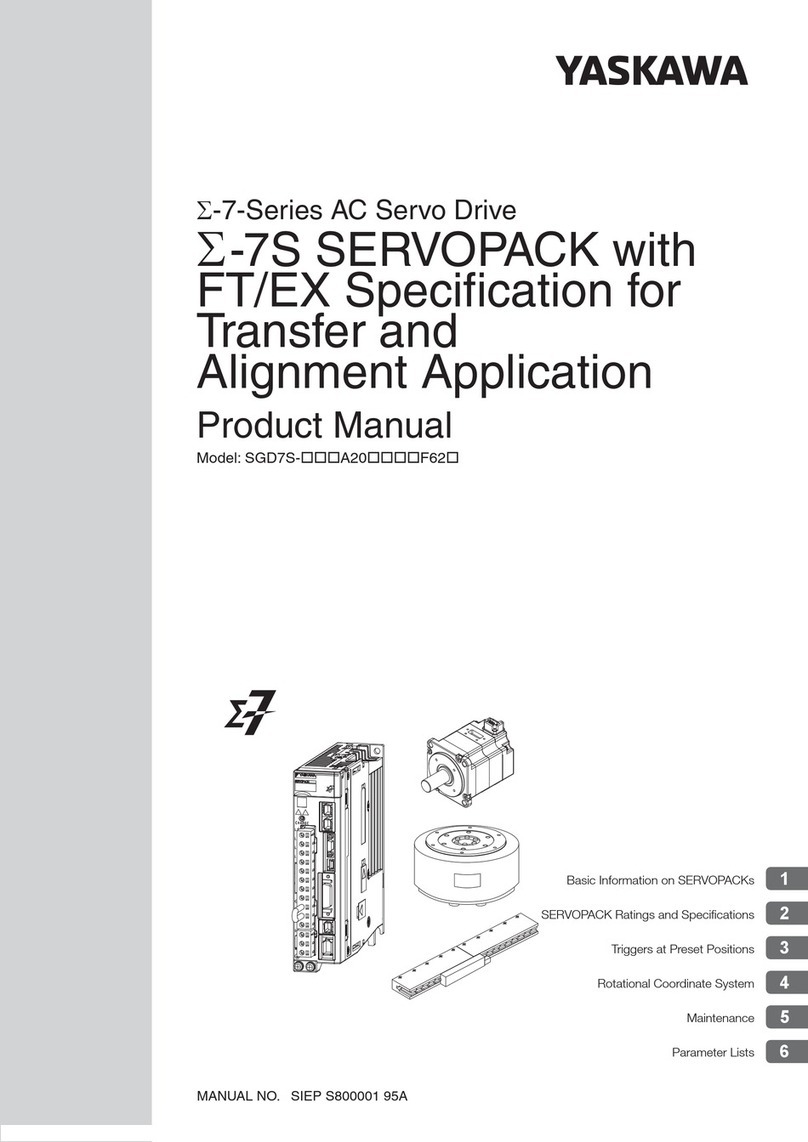
YASKAWA
YASKAWA SGD7S-***A20****F62 Series product manual

Linear Technology
Linear Technology LTC3210 quick start guide
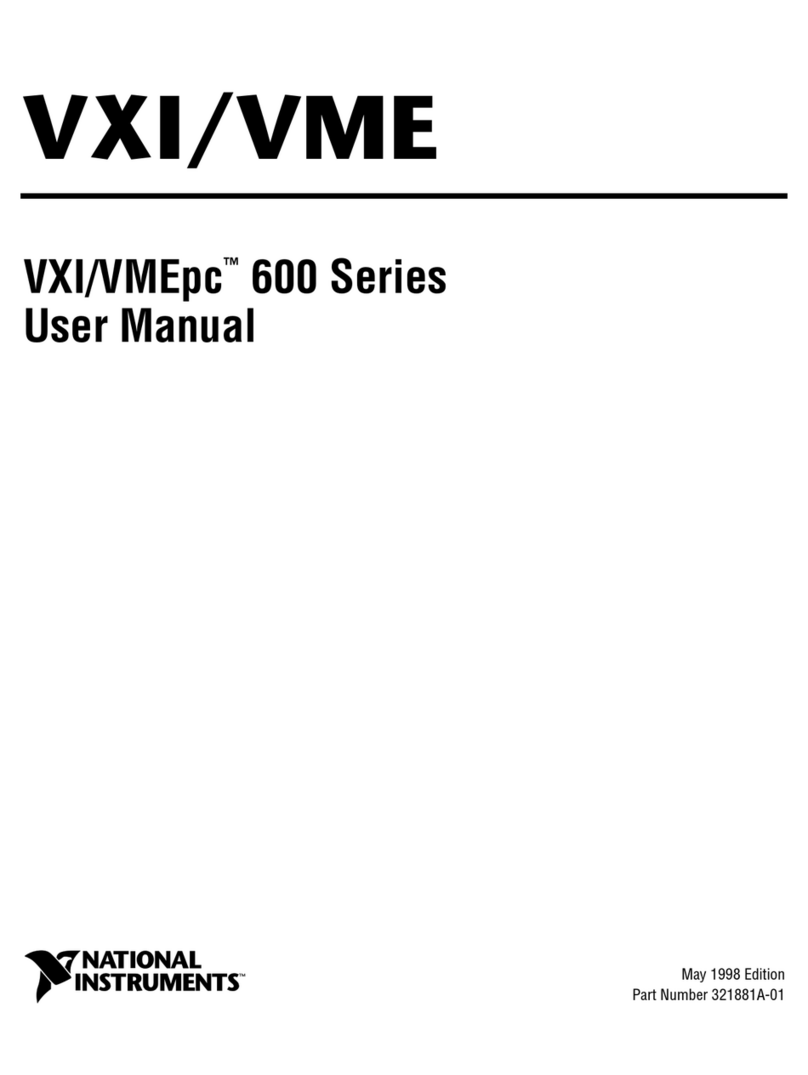
National Instruments
National Instruments VXIpc 600 Series user manual
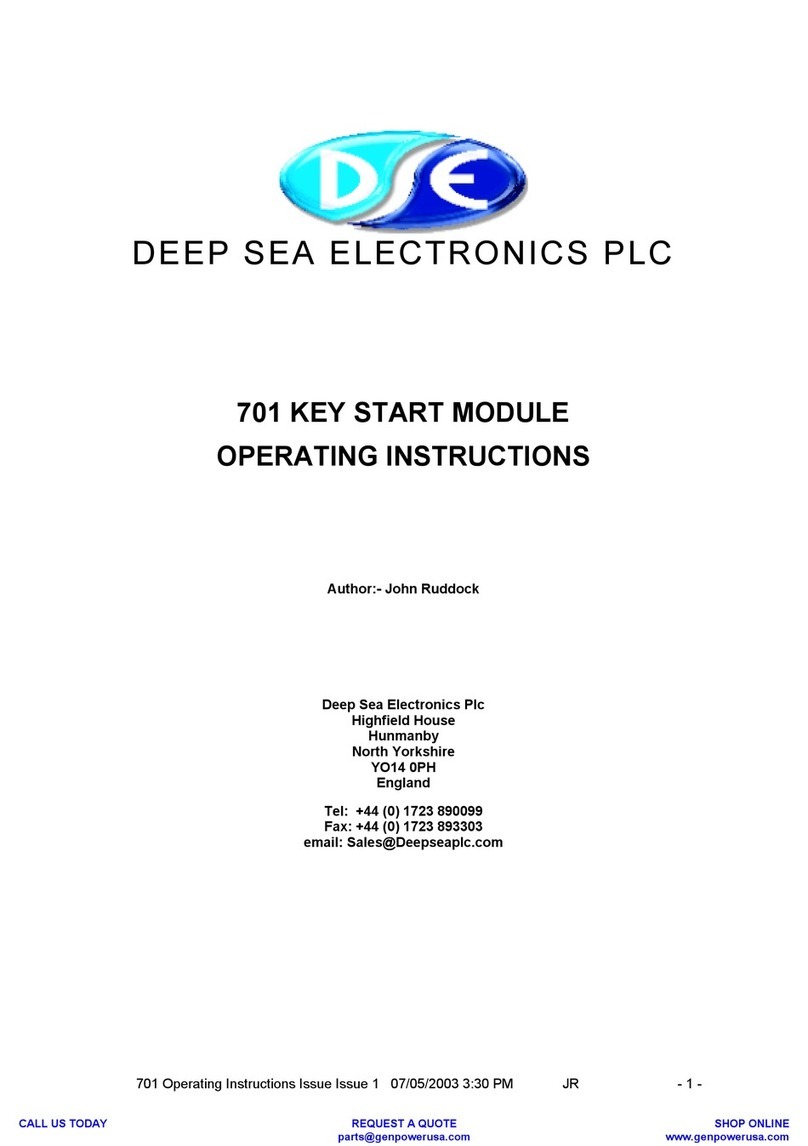
Deep Sea Electronics Plc
Deep Sea Electronics Plc 701 operating instructions
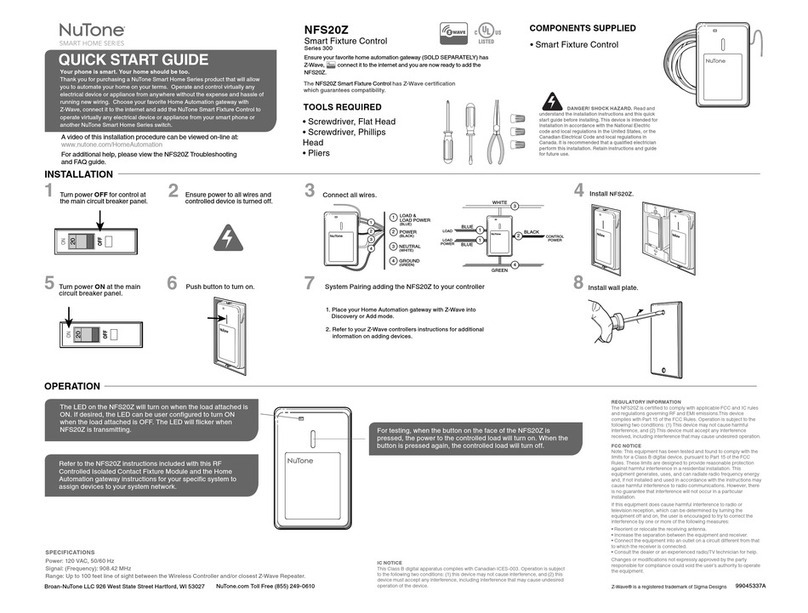
NuTone
NuTone Smart Home Series quick start guide
